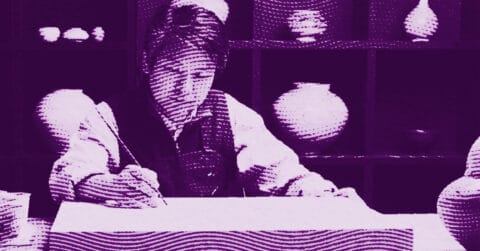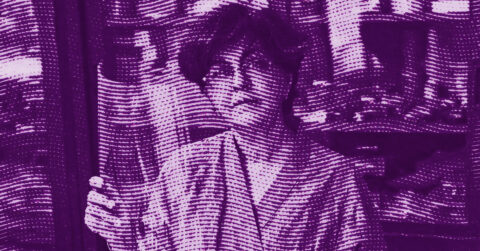Listen to me carefully, you bunch of snobs! You are there, champagne glass in hand, pretending to understand art while you imagine that expressionism consists of making faces in front of your bathroom mirror. But let me nevertheless talk to you about Evelyn Hellenschmidt. This artist who, far from considering herself a comet or a shooting star, has carved her path with determination in the sometimes hermetic world of contemporary art.
Born in 1962 in Eltville, Germany, and having lived for years in Spain, Hellenschmidt has managed, with remarkable perseverance, to build a visual language that is her own. Her journey is all the more impressive since she is self-taught, having learned, as she herself says, “on the street,” frequenting artists’, ceramists’, and sculptors’ workshops from a young age, even working in a forge to learn how to weld. It is this intimate knowledge of materials that gives her works a striking authenticity.
But it is above all the universe she creates that deserves our attention. Hellenschmidt develops an art that, rather than shouting to be heard, whispers complex truths about our human condition. Her sculpture “Silencio” (2006), initially created for the Museum of Contemporary Art of Yucatan in Mexico, is emblematic of this approach. A monumental work in galvanized welded iron that traveled across Spain before finding its final home at the Kunsthaus Taunusstein in Germany. The artist explores there what she calls “enfermedad y remedio” (illness and remedy), echoing her own quest for a space of silence in the face of the pressures of the art world.
This reflective dimension of her work leads us to consider the influence of Sartrean existentialism in her oeuvre. Jean-Paul Sartre, in “Being and Nothingness,” develops the idea that man is “condemned to be free” and must assume responsibility for his choices in a world devoid of predetermined meaning [1]. Hellenschmidt’s sculptures, particularly her “Barcas de posibilidades o barcas del hambre” (“Boats of possibilities or boats of hunger”) (2008), evoke this existential condition. These boats, inspired by illegal immigration between Morocco and Spain, are not simply sociopolitical comments, but visual metaphors of existential freedom, both tragic and magnificent.
As Sartre writes: “Man is nothing else but what he makes of himself” [2]. This philosophical vision deeply resonates in Hellenschmidt’s installation which, in her own words, “speaks about the possibilities for human beings to thrive, depending on where they were born.” The artist confronts us with this harsh truth: existential freedom is constrained by the circumstances of our birth and environment.
Hellenschmidt’s work possesses that rare quality of transforming cold industrial materials such as brass, copper, bronze, and iron into structures that breathe, vibrate, and tell stories. She achieves this not through grandiloquence, but through the pursuit of an essential geometry, a purity of lines that reflects the fragility of our own existence.
And it is precisely this fragility that lies at the heart of her work “Barca de tierra” (2008), a synthesis of what she calls “the desire for vital lightness and resistance, despite existential fragility.” Isn’t this a perfect illustration of the human condition according to Sartre, this constant tension between our aspiration to transcendence and our rooting in immanence?
Allow me now to address a less obvious but equally interesting aspect of Hellenschmidt’s work: her relationship with Bachelardian poetics of space. Gaston Bachelard offers us valuable tools to understand the spatial dimension of Hellenschmidt’s work.
Let’s take “Terreno II” (2006), a sculpture in brass, copper, and bronze that earned her the first prize from the Jacinto Higuera Museum. This work was born from a personal experience: the purchase of land to build a cabin, a refuge against the inherent instability of the artist’s life. This gesture of anchoring, this search for a space of one’s own, aligns with what Michel Foucault, in “Of Other Spaces,” calls “heterotopias,” those concrete spaces that harbor the imagination [3].
Hellenschmidt’s work is sprinkled with these heterotopias: small boats, territories, fountains, groves. “Bosquecillo” (2007), a monumental installation that traveled from Barcelona to Madrid via Caceres, immerses us in a poetic space that transcends its materiality. It is a place that, as Foucault writes, “is capable of juxtaposing in a single real place several spaces, several sites that are in themselves incompatible” [4].
This creation of alternative spaces is especially significant when considering Hellenschmidt’s interest in the writer and philosopher Gao Xingjian and his work “For Another Aesthetic” (2000). The artist draws from it the importance of “inner versions” in artistic practice, an approach that echoes the phenomenology of space developed by Foucault.
“Fuente (maqueta)” (2006), presented at the Valencian Institute of Modern Art (IVAM), gives us another illustration of this spatial poetics. The fountain, a symbol of water as the “origin of everything,” becomes under Hellenschmidt’s hands a space for meditation on our connection with nature and our own interiority. As she explains: “Water is permanence, necessity, and consolation. It provides us with the most basic and can create the most refined.”
It is remarkable that Hellenschmidt, while exploring universal themes, remains anchored in a personal and intimate experience. Her work testifies to a constant search for what Foucault calls “a kind of contestation both mythical and real of the space where we live” [5]. This contestation is never violent or noisy but subtle and poetic.
In 2022, Evelyn Hellenschmidt was one of the three winners of the Luxembourg Art Prize, a prestigious international contemporary art award, a well-deserved recognition for an artist who, since the 1980s, has continually forged her own path with quiet determination. Her award crowns a career marked by international exhibitions, from Korea to Spain, from Germany to the United States.
What strikes about her work is the ability to create pieces that withstand time and fleeting trends. While so many artists desperately seek to reinvent themselves each season, Hellenschmidt pursues a coherent exploration of themes dear to her: the fragility of existence, the search for a place of one’s own, the tension between grounding and flight.
Her path to photography starting in 2011, with studies at the international school EFTI in Madrid, testifies to this organic evolution rather than artificial breaks. By obtaining the prestigious Pollock-Krasner grant (USA) the same year, she confirms her status as an international artist.
Art lovers seeking an authentic experience would do well to linger before Evelyn Hellenschmidt’s works. Not to look for spectacular effects or easy provocations, but to immerse themselves in a universe where each piece is the result of deep reflection on our human condition. A universe where, as Sartre would have said, existence precedes essence, where each creation is an act of freedom in the face of the world’s absurdity.
The next time you sip your champagne in a gallery pretending to understand what is happening, remember that there are artists like Evelyn Hellenschmidt who create not to impress you, but to give shape to essential truths about our existence. Artists who, rather than thinking of themselves as misunderstood geniuses, work with humility and perseverance to build a coherent and sincere body of work.
And if you have the chance to find yourself in front of one of her works, take the time to truly observe it. Let yourself be carried by these forms which, in their apparent simplicity, tell complex stories about our relationship to the world, to space, and to ourselves. It is there, in this silent encounter between the work and the viewer, that the true magic of art resides.
- Sartre, Jean-Paul. (1943). Being and Nothingness. Gallimard, Paris.
- Sartre, Jean-Paul. (1946). Existentialism is a Humanism. Nagel, Paris.
- Foucault, Michel. (1984). Of Other Spaces. Architecture, Movement, Continuity, No. 5, October 1984.
- Ibid.
- Ibid.
















